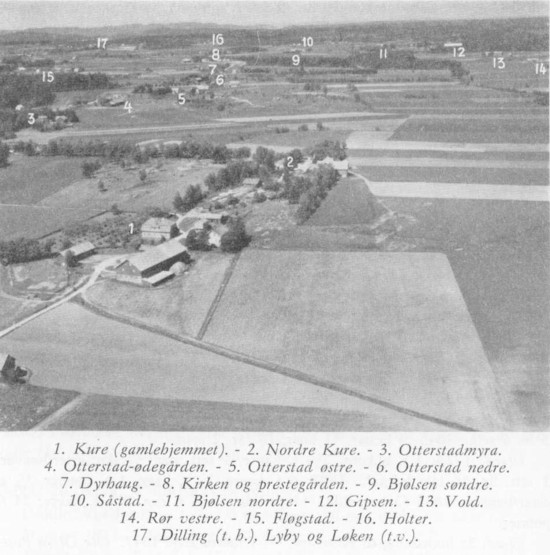| Author |
 Topic Topic  |
|
Borge
Veteran Moderator
    
Norway
1301 Posts |
 Posted - 05/02/2004 : 20:56:08 Posted - 05/02/2004 : 20:56:08


|
quote:
Originally posted by James E Heg
Can you translate "Gårder og Slekter" for me?
Jim, it translates "Farms and Families". This is what we cal "Bygdebok" a local history book which handles the history of the settlements and the people who lived there, just like the Lier book. "Rygge Gårder og Slekter has more information about you people than what I posted here.
quote:
Where is Harum?
Hurum is a place not far from Drammen, the peace of land making a tongue between Drammensfjorden and the Drøbak sound
quote:
What does Otterstadmyren mean in the context of all those farm divisions and integrations?
Directly translated it will be the Otterstad marsh.
quote:
In your 8 December post you say, "now see this scan." I have copied it, enlarged it, studied it, but can retrieve no useful info.
It is a scan of the original entry in the church record "Utflyttede" (out-migrants), showing entry # 7, April 1843: Konen (wife - i.e. married woman) Marthe Hansdtr. Skoven, age 57 - destined for Wisconsin in North America. Entry # 8 is Sønnen (the son) Martin Christiansen, age 23 - destined for the same place (samme sted)
quote:
The 1801 Rygge census shows Søren and Peder Hansen as being in the Army. Was compulsory military service in force at that time?
Yes! In the book it is says that Kure's son Even was rewarded a piece of his father farm in 1810 for doing such a good effort while all of his brothers were fighting in the war, (the Napoleonic wars, Norway was in a union with Denmark, under the rule of the Danish King, who was in alliance with Napoleon) btw. Hans Christian Pedersen Kure is titled as "dragoon tambour" in the book. quote:
Can you tell me the significance (if any) of the people I listed in my 14 December post? I now note that in the Rygge census these people are not separated from the Hans Christian Pedersen group, though they were in my original data.
Obviously, those are Christian Larsen Skogen and his parents in the 1801 census. |
Børge Solem |
 |
|
|
James E Heg
Member of honor
  
USA
135 Posts |
 Posted - 12/02/2004 : 22:31:11 Posted - 12/02/2004 : 22:31:11


|
A few Loose ends. What is the significance of the Kure at the end of Hans Christian Pedersen Kure? And Mand at the end of Lars Christiansen's name? Also I find Bruk meaning "use" but do not find Brukere. I find Store-Valle and know that "stor" means large but no form of Valle appears in my dictionary. I want to say "big valley" but find "dal" for valley. Finally, what exactly is a klokker? This word comes up all the time in my research and Norwegian history books. Some sort of a churchman? Bell ringer? Sexton? Vestryman? Wise man? I do try but my dictionary is more confusing than helpful.
På forhånd Takk. Jim |
 |
|
|
Borge
Veteran Moderator
    
Norway
1301 Posts |
 Posted - 13/02/2004 : 18:18:00 Posted - 13/02/2004 : 18:18:00


|
According the earlier mentioned Rygge book "KURE" is the name of the farm where they lived. The meaning of the name might be after the river "Kure-åen" (i.e. Kure-river). Looking at the old map printed in the book I see names as "Kure fjord", "Kure hill", "Kure mash" and so on. There are a few generations back from Hans Christian Pedersen mentioned as "brukere" on the Kure farm. "Bruker" is directly translated "user", the man who used the land, rented or owned. A user did not necessarily own the land. I'll see if I can translate some of it for you later. Did you get in contact with Knut about the Skogen family?

("Gårder og Slekter i Rygge" vol 1, by Ingeborg Flood, Rygge Sparebank 1957 - page 134)
"Valle" is probably an old for of "Vold" - "Voll" (the old for is "Vellir") according to O. Rygh. My dictionary tells me it is a mound or dike, wall or rampart. A look at the map should help giving a logical understanding, as farm names are often descriptions of the landscape where the farm is located.
"Klokker" is a kind of parish clerk, and he was often responsible for ringing the bell, the music and assisted the minister.
|
Edited by - Borge on 13/02/2004 20:00:33 |
 |
|
 Topic Topic  |
|
|
|